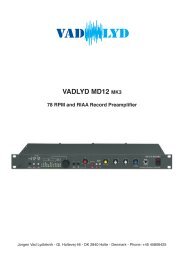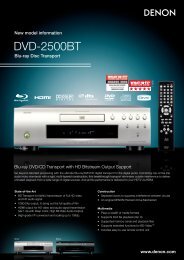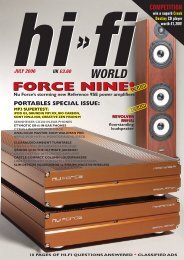Floorstanding Loudspeakers Focal Electra 1037 Be ... - Sound Hi Fi
Floorstanding Loudspeakers Focal Electra 1037 Be ... - Sound Hi Fi
Floorstanding Loudspeakers Focal Electra 1037 Be ... - Sound Hi Fi
You also want an ePaper? Increase the reach of your titles
YUMPU automatically turns print PDFs into web optimized ePapers that Google loves.
Stereophile: <strong>Focal</strong> <strong>Electra</strong> <strong>1037</strong> <strong>Be</strong> loudspeaker<br />
http://www.printthis.clickability.com/pt/cpt?action=cpt&title=Stereophile%3A+<strong>Focal</strong>...<br />
Page 11 of 14<br />
15/06/2009<br />
that the reflex alignment is not quite optimally tuned. The woofers roll off above 120Hz,<br />
crossing over to the midrange unit (green trace) with symmetrical second-order slopes at<br />
160Hz, and are well-behaved outside their passband. The port, however, has a severe<br />
peak at 350Hz, this suspiciously close to the frequency of the panel resonance noted<br />
earlier. Fortunately, the port fires down into the carpet, which will work against the audibility<br />
of this mode.<br />
<strong>Fi</strong>g.3 <strong>Focal</strong> <strong>Electra</strong> <strong>1037</strong> <strong>Be</strong>, anechoic response on tweeter axis at 50", averaged across<br />
30° horizontal window and corrected for microphone response, with the nearfield<br />
responses of the midrange unit (green), woofers (blue), and port (red) plotted below<br />
500Hz, 1kHz, and 600Hz, respectively, along with their complex sum plotted below 300Hz<br />
(black).<br />
The complex sum of these nearfield bass responses, taking into account both acoustic<br />
phase and the differing distances from each radiator to a nominal farfield measuring<br />
position, is shown as the black trace below 300Hz in fig.3. There is the usual boost in the<br />
upper bass, due to the nearfield measurement technique, but the <strong>Electra</strong> <strong>1037</strong> <strong>Be</strong> actually<br />
shows good low-frequency extension. And the midrange and treble, assessed across a 30°<br />
horizontal angle on the tweeter axis, are superbly flat overall. There is a slight on-axis uptilt<br />
between 4 and 11kHz, and the tweeter's increasing directivity above 10kHz gives rise to an<br />
apparent slight lack of energy between that frequency and 23kHz, but these are minor<br />
departures from perfection. And note how the beryllium-dome tweeter's response is still at<br />
full level at the graph's upper limit of 30kHz.<br />
The <strong>Focal</strong>'s horizontal dispersion (fig.4) is actually even, the apparent flare between 3 and<br />
5kHz resulting from the fact that a slight on-axis suckout fills in to the sides of the tweeter<br />
axis. The tweeter does get quite directional above 12kHz, however. In the vertical plane<br />
(fig.5), the <strong>Focal</strong>'s balance doesn't change appreciably over quite a wide angle, even with<br />
the separation between the midrange unit and the woofers taken into account. A suckout<br />
does develop at the upper crossover frequency for standing listeners. Don't stand up while<br />
listening to this speaker!







